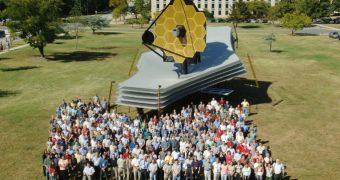Scheduled for launch in 2015, the James Webb Space Telescope will arguably be one of the most complex pieces of technology ever sent to the Earth's orbit. Its massive antenna was constructed in such a way that it would be able to peer back into the earliest history of the Universe, and identify the first stars and galaxies that were formed after the Big Bang. Even though this line of investigations is its main objective, the team behind JWST believes that the telescope will also be able to detect a host of exoplanets, orbiting distant, far-away stars. In addition, the scientists also believe that James Webb's amazing resolution will allow them to look at the chemical composition of these exoplanets.
“Webb was originally conceived to search for the first galaxies and address the big cosmological questions associated with them, but we now know it can contribute powerfully to the planet hunt. Exoplanets are tremendously exciting. The field is changing literally by the day. I gave a talk on exoplanets the other day, and in the time between writing and delivering the speech, astronomers announced 30 new planets!” Mark Clampin, an expert at the NASA Goddard Space Flight Center, in Greenbelt, Maryland, explains. The James Webb will observe the Cosmos in infrared wavelengths, and is destined to be the successor of the renowned Hubble Space Telescope.
But the JWST could also work together with other observatories, such as NASA's newly launched WISE mission, or the Kepler planet-hunting telescope. These instruments, as well as others, could analyze potential exoplanets superficially, and then send their coordinates to the James Webb telescope. This type of collaboration would ensure that the maximum amount of scientific data is extracted from the space objects. The problem is that the exoplanets are hiding in the light of their parent stars. “It’s like trying to find a firefly’s flash in the beam from a lighthouse. But there are ways to do it!” GSFC Webb Deputy Senior Project Scientist Jonathan Gardner explains.
“Webb will measure the total light the star emits and then measure the amount of light when the planet crosses in front. This telescope can even detect brightness changes that occur when the planet passes behind the star. With some Doppler measurements from ground-based surveys, all this information helps us determine the planet’s mass and radius, and then astronomers can start to think about the planet’s composition,” the scientist adds. “By comparing the two spectra for the star (in and out of transit), we can extract the planet’s spectrum and learn about the planet’s atmosphere. We have to collect a lot of infrared light – a billion or more photons – for each spectral element to isolate features. Webb is perfect for this kind of study,” Clampin concludes, quoted by Space Fellowship.

 14 DAY TRIAL //
14 DAY TRIAL //